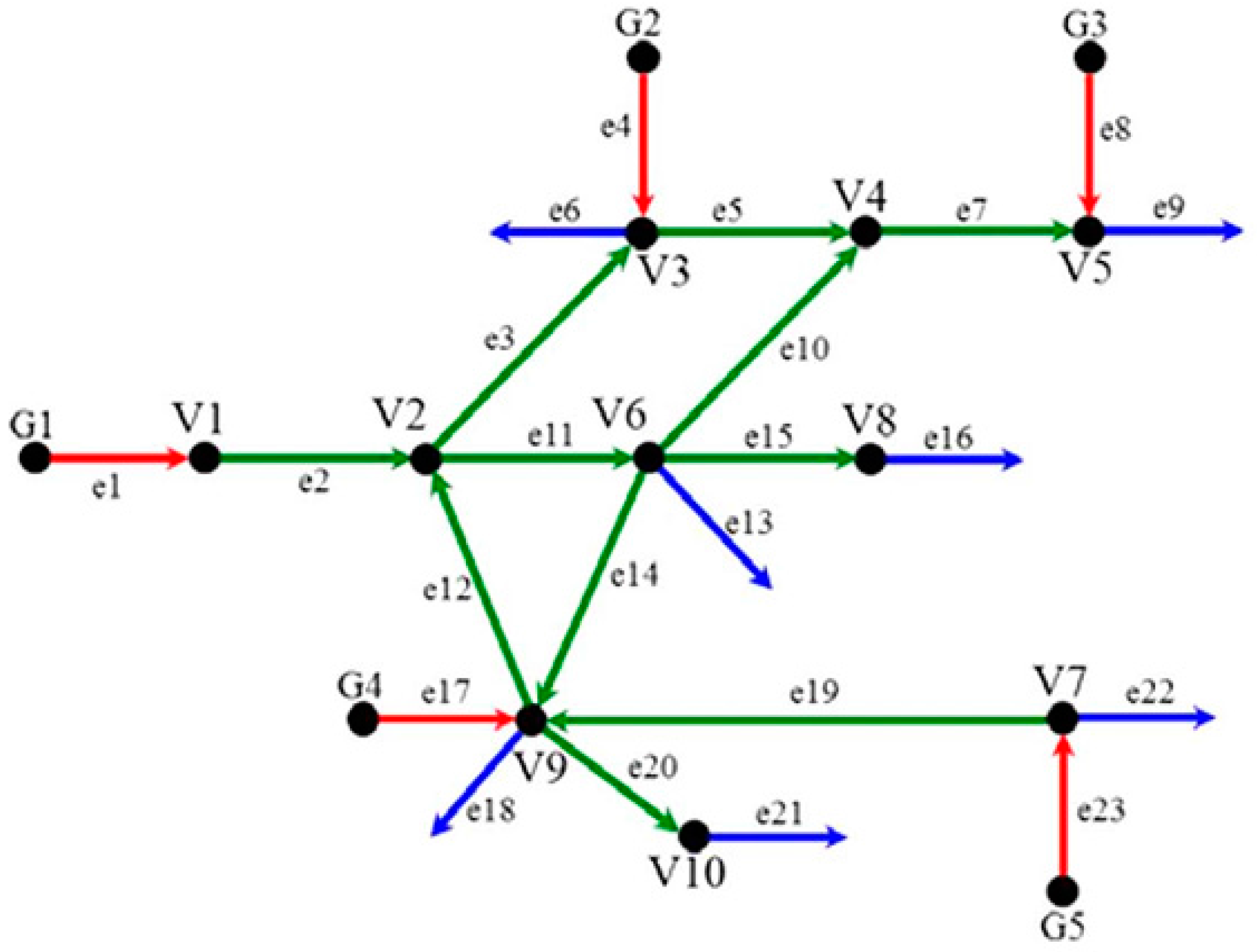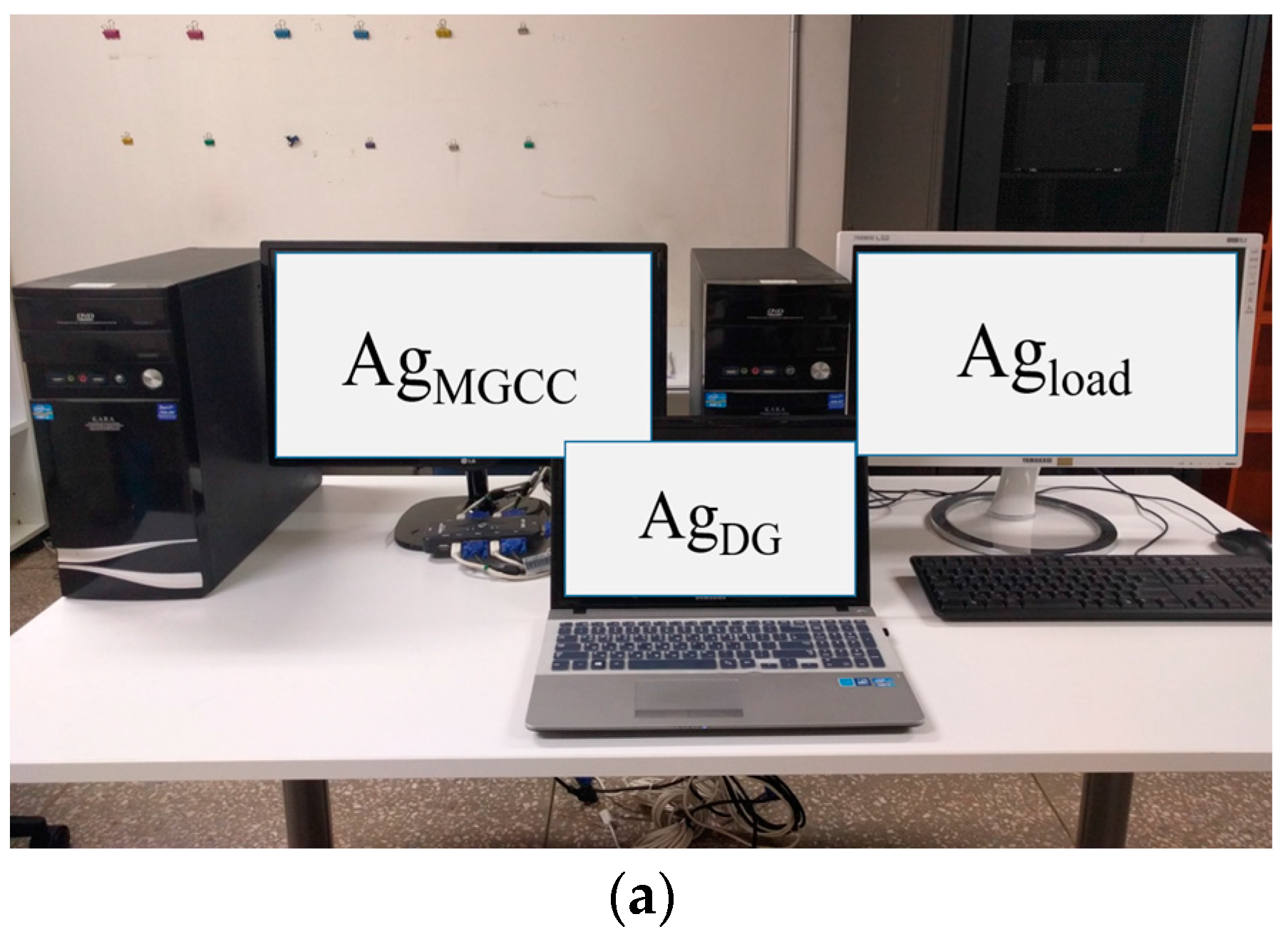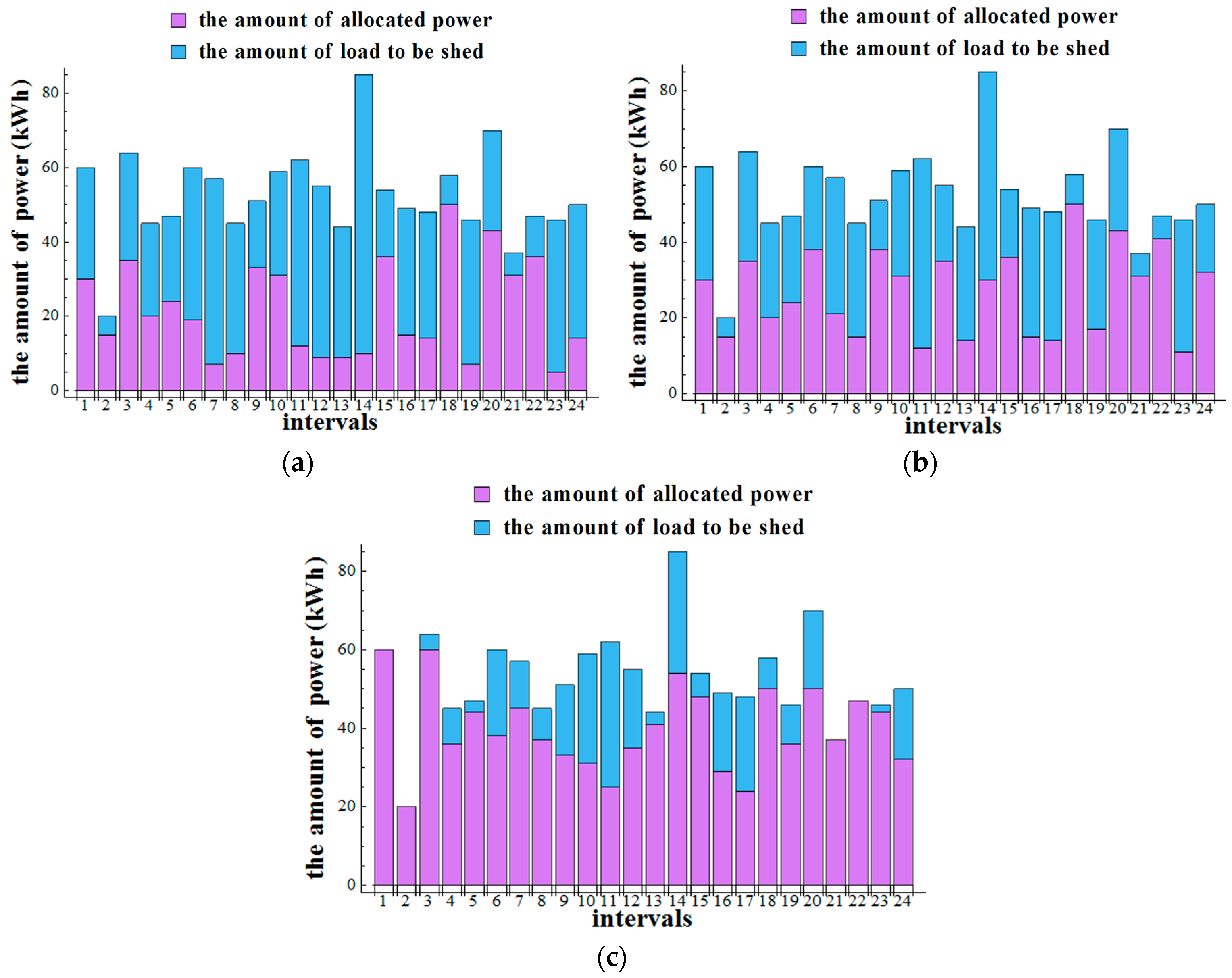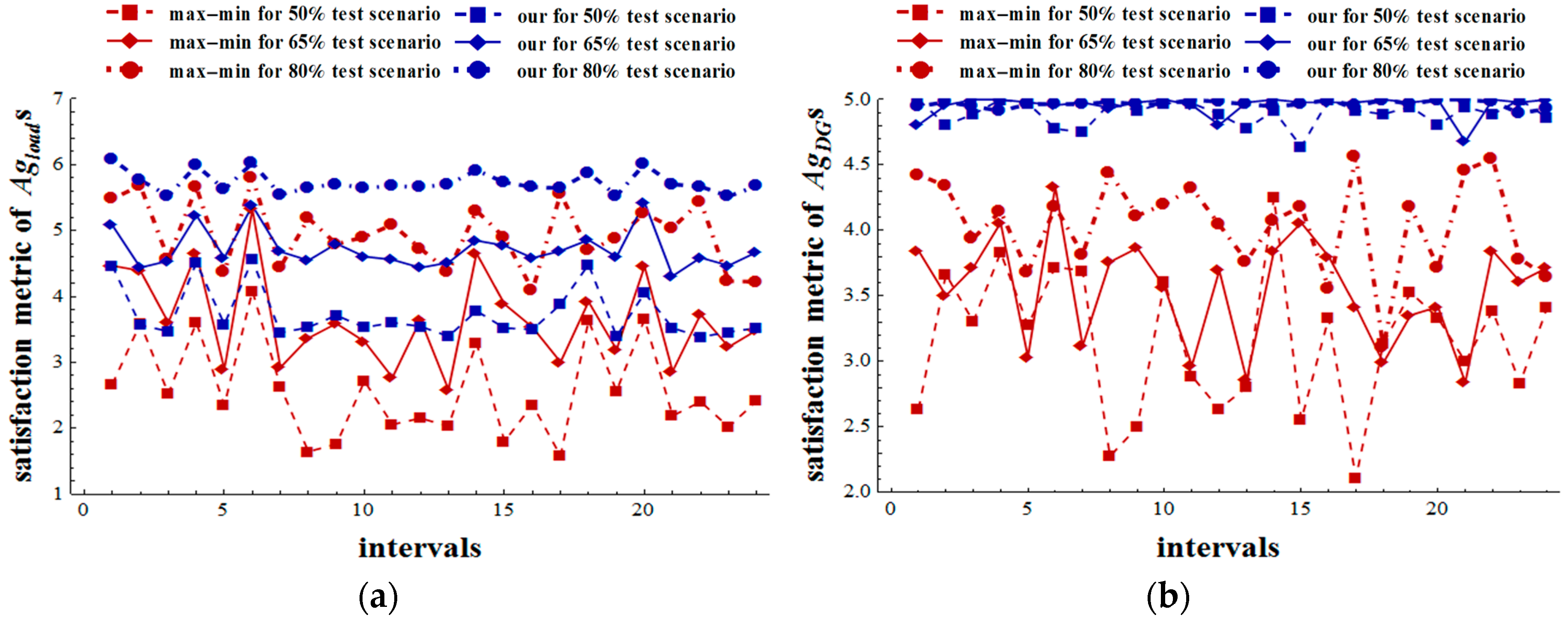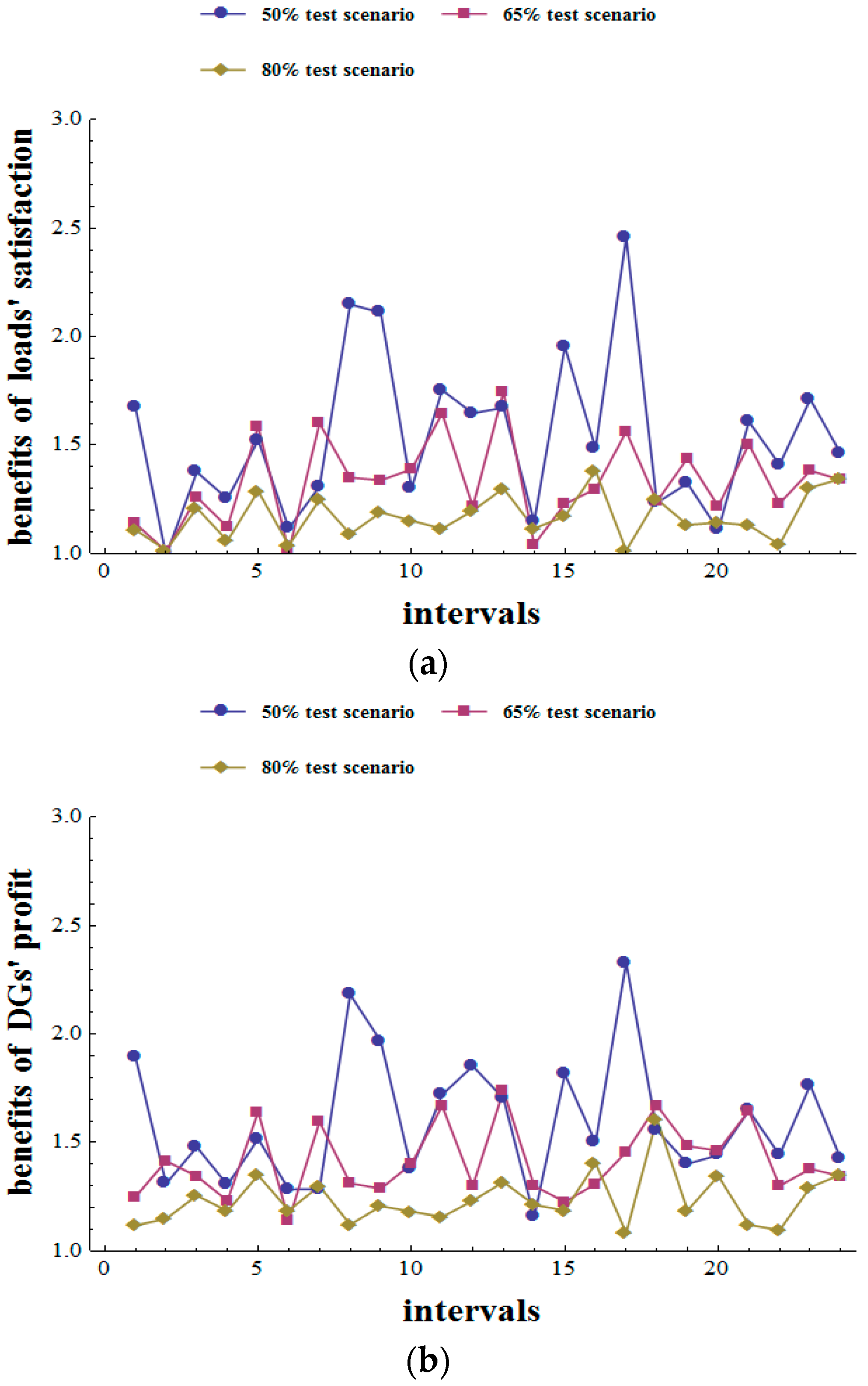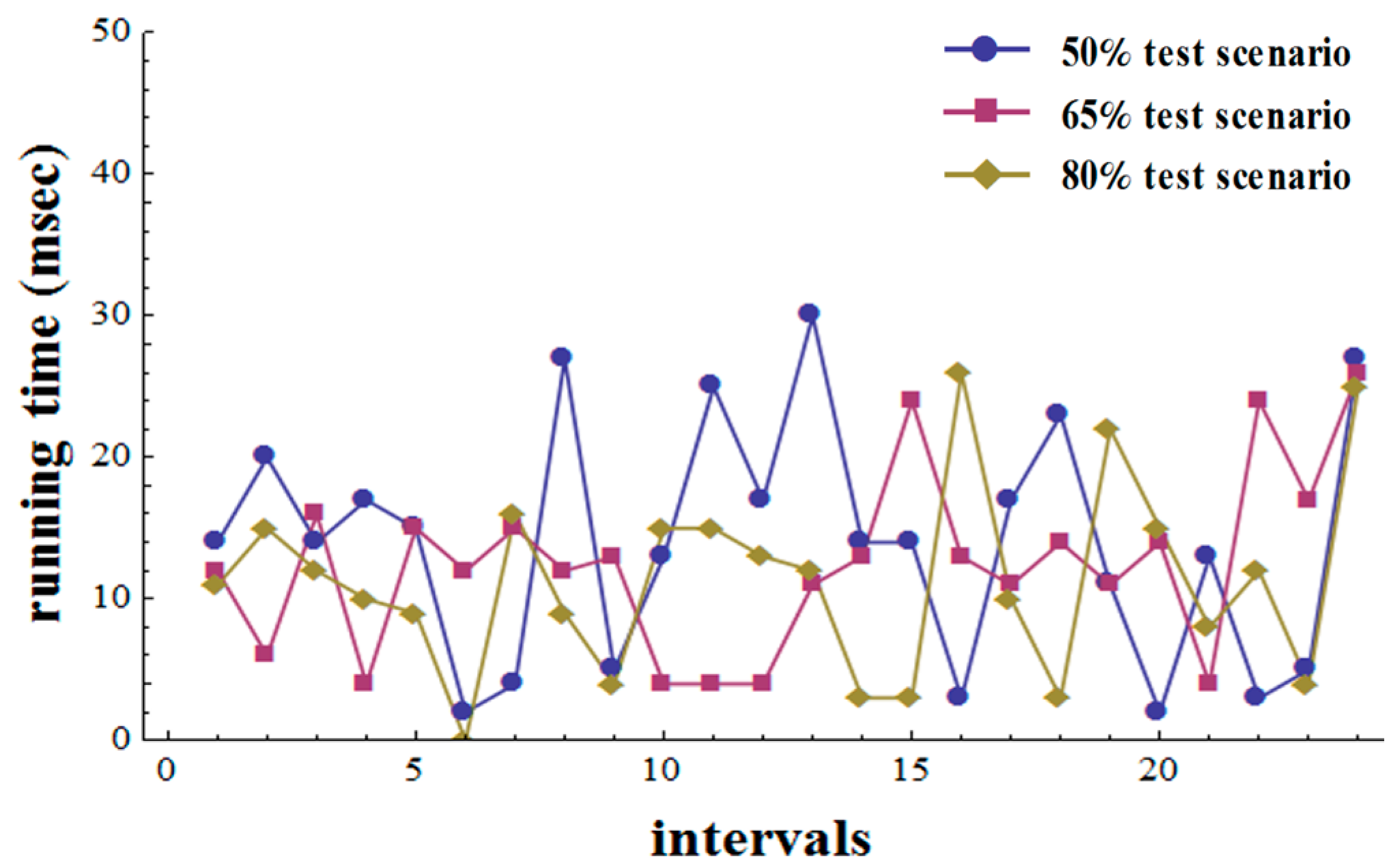1. Introduction
Recently, microgeneration has been considered for use in managing the growth of electric power demands and CO
2 emission. The Consortium for Electric Reliability Technology Solutions (CERTS) has initiated research on the impact of connecting small generation units to low-voltage electricity distribution systems in order to enhance the reliability of a utility grid system. Accordingly, a microgrid (MG) has been introduced [
1]. An MG is a small-scale autonomous power system that operates either in parallel to or islanded from utility main grids. An MG allows for fast installation of electricity supply without the need for expensive transmission infrastructure investments. It is composed of on-site distributed generators (DGs), energy storages (ESs), and loads [
2]. DGs are power generators such as renewable energy sources (e.g., photovoltaic (PV), wind, or solar) and conventional generators such as microturbines or diesel generators. ESs include lithium-ion batteries. They can be either power generators that produce power or power consumers that expend power. Loads such as residential or commercial buildings are power consumers.
An MG has two operational modes: grid-connected and islanded. A grid-connected operation indicates a situation in which an MG is connected to the main grid. An islanded operation indicates a situation in which an MG is disconnected from the main grid when a fault occurs in the grid. The amount of produced power of DGs depends on the demands of loads. The difference between the generated power and load demand is controlled by the well-functioning main grid in the grid-connected MG. On an islanded MG, because the main energy sources are renewable energy sources that have an uncertain nature, the amount of produced power may not controlled. Thus, the control is commonly accomplished by a load shedding system, not a mechanical controller.
Load shedding is a process in which some of the power demands are shed to protect MGs from potential dangers [
3]. Two architectures for load shedding, centralized and decentralized, have been investigated [
4]. In a centralized architecture, system components are controlled by a central control system, which can lead to optimal utilization of MG resources. In a decentralized architecture, individual components cooperatively or competitively share the power supply or power demand based on their individual capabilities. A decentralized architecture can easily integrate new components. However, real-time optimal utility under various operating conditions is not possible. Although considerable research on load shedding systems such as islanding detection and autonomous operation/management have been extensively studied [
5], research on load shedding algorithms remain an open issue for further research. A load shedding algorithm determines the amount of power demand that can be reduced. In general, a load shedding algorithm finds the most stable equilibrium operating point for the system with the fewest shed demands. In other words, a load shedding algorithm is designed to make full use of limited generation resources and maximize the beneficial performance [
6]. In this study, we propose a load shedding algorithm for the optimization problem in a centralized architecture of an islanded MG. We use the satisfaction of an MG system player as performance criteria.
In this paper, the major contributions are:
- -
Identifying the satisfaction of system components as performance criteria;
- -
Defining the optimization problem to maximize the satisfaction;
- -
Developing a load shedding algorithm for the optimization problem;
- -
Implementing a multi-agent system (MAS) for the load shedding algorithm;
- -
Performing experiments to verify performance of the implemented system.
The remainder of the paper is organized as follows. In
Section 2, we describe related studies and system models. In
Section 3, we propose a load shedding algorithm for the optimization problem to maximize player satisfaction. In
Section 4, experimental results are discussed to verify the performance of our algorithm based on an implemented system operating in a conventional development framework. Finally, a conclusion and future research directions are provided in
Section 5.
3. Proposed Load-Shedding Algorithm
In this section, we devise an optimization scheme for load shedding to maximize the satisfaction of the system player. The system player is divided into power suppliers such as DGs and ESs and the power consumers such as loads and ESs. In this study, we use DGs as power suppliers and loads as power consumers. The system optimum is achieved when the satisfaction of both the DG and load are maximized. Given
and
which are the satisfaction indices of the load
and DG
in the load shedding,
and
indicate utility functions of the load and the DG at a specific time interval. The time-dependent utility models general situations in which the load and DG may have various load demands and may supply power at different time intervals. We assume that
and
are continuously differentiable, strictly concave, and increase over the range
and
[
21]. In this model, our optimization problem is given by:
Our optimization problem is divided into two parts: that of the load and that of the DG. First, we define the utility function from the load point of view. The utility function of the load reflects the satisfaction of power allocation and the dissatisfaction of power shortage. We analyze the relationship between the preference of a subdemand and the satisfaction. The satisfaction is achieved when the power is assigned to the subdemand with high preference greater than that when the power is assigned to the subdemand with a relatively low preference. Thus, we assign the power to subdemands in the order of high preference to low preference. To obtain the numerical value of the load satisfaction, we calculate
which is given by:
subject to:
where
indicates
. The satisfaction index of the subdemand
in the load
is given by:
where
is the preference weight of the subdemand
. It is given by:
where
is the preference of the subdemand
. The satisfaction index of the load
,
is given by:
subject to:
where
is a binary variable taken to be 0 or 1 for the linear programming problem. Thus, the satisfaction value of the load
is given by:
subject to:
where
The variable
indicates the negation of
. In other words,
. The variable
denotes the sensitivity to the preference of
. In Equation (10), the first term indicates the satisfaction of power allocation for
and the second term indicates the dissatisfaction for
resulting from the power shortage. Thus, the utility function of the load is defined as follows:
In the second part of our optimization problem, we define the utility function from the DG point of view. The utility function of the DG reflects the satisfaction of the power sale and the dissatisfaction of the power surplus. The uncertainty of power generation is one of the important features when a load selects its power supplier. It is because the amount of produced power by DGs is not estimated exactly in an islanded MG with renewable energy sources. For dealing with the uncertainty, we assign the uncertainty value to each DG according to the deviations of forecasted amounts of produced power in long-term historical data [
17]. Using
in Equation (4), the subdemands of
loads,
, are assigned to DGs in the order of low to high uncertainty. The satisfaction index of the DG
,
is given by:
where:
and
subject to:
Thus, the satisfaction value of the DG
is given by
where
is the sensitivity to the surplus power of
. The utility function of DG is defined as follows:
Therefore, our optimization problem is described as follows:
4. Performance Evaluation
An MAS is presented as an effective solution for a centralized or decentralized MG system [
22]. Thus, we implemented an MAS for the load shedding management of an islanded MG using a Java Agent Development Environment (JADE) framework (Telecom Italia Lab, Torino, Italy) [
23]. The MAS operating on JADE emulates distributed load shedding operations. To optimize load shedding, the MAS was linked with the IBM CPLEX Optimizer (IBM, Armonk, NY, USA) [
24], which is a mathematical programming solver for linear programming.
We configured our system with MG central control (MGCC), using DGs as power generators and loads as power consumers. The components were classified according to operational capabilities and assigned appropriate control agents:
,
, and
[
25]. One major functionality of MAS is the communication among the distributed agents. By using the Foundation for Intelligent Physical Agents (FIPA) guidelines for agent-based communication, FIPA-Contract Net Protocol (CNP) performatives are standardized [
26]. The performatives included CFP (Call For Proposal), PROPOSE, REFUSE, ACCEPT, REJECT, FAILURE, and INFORM.
Figure 1 shows the message flows when using the FIPA-CNP performatives. The MG operation follows an interval-based planning paradigm. First, the
sends a CFP message to
s and
s to produce a load shedding plan of the next interval (e.g., interval
). The
s and
s respond with PROPOSE messages to send their information to the
. Such information includes the amount of power generated or the number of power demands. Each
additionally sends a list of subdemands with their preferences. If the supplied power is less than the demanded power, the
initiates the load shedding scheme to determine the number of shed demands of the loads. Once the number of shed demands is determined, the
sends ACCEPT messages to notify the
s and
s of the results of the load shedding. For the
s, the amount of power to be supplied to the loads is given. For the
s, the number of shed demands and the amount of power to be allocated to the loads are given. The notified load shedding plan is implemented at time interval
t. The load shedding planning and implementation procedures repeat at each interval.
To show the functionality and feasibility of our algorithm, we configured the system with one
, five
s, and seven
s. The modified CERTS MG consists of five generators, seven loads, and 23 breakers [
27]. A graphical representation of normal operation of the modified CERTS is shown in
Figure 2.
Figure 3 shows the system in a distributed environment based on three PCs. The left subfigure shows the test environment of our laboratory. One
is on the first PC, five
s are on the second PC, and seven
s are on the third PC. The Internet is used for inter-agent communications. The right subfigure shows the operational process on the implemented JADE system. In our system, for the sake of experiments, we assume that the critical load demands
and
. The total controllable load demands
is set to
and the total supply
is set to 50%, 65%, or 80% of the total load demands. For
and
, we set both of them to 1. The uncertainty values of DGs are set to the same value. The details of load data is given in
Table 2 and the subdemands (
) for each load are sorted by preference (
) in ascending order from the value ‘1’. We set
to 10. We divided the time in a day to 24 intervals for MG operation, and the length of an interval was one hour. The amount of demand of an
for each interval follows a Poisson distribution.
Figure 4 shows the functionality of our load shedding algorithm in three test scenarios. In experiments, the total power supply was set to
for 50% of the total load demands (
50% test scenario),
for 65% (
65% test scenario), and
for 80% (
80% test scenario). The subfigures show the number of shed demands of 3
for 24 time intervals. In the figures, the height of a bar indicates the number of power demands, and the violet color of a bar indicates the amount of allocated power to the load. The blue color of a bar indicates the number of shed demands of the load. At each interval, as the power demands of the load changes, the number of shed demands accordingly changes. In addition, as the power supply increases, the number of shed demands decreases. In the experiments, the power was assigned about 42%, 52%, or 77% of the demands to 3
for 50%, 65% or 80% test scenarios.
The plug-and-play functionality is one key feature of multi-agent based optimization systems. Thus, to investigate the plug-and-play functionality of our system, we configure that DG
(
among five DGs is removed and added at intervals 11 and 15.
Figure 5 shows that our system is feasible for plug-and-play operation when
is changed from
to
.
To verify the performance of our algorithm, we compared it with the max–min fairness algorithm. In the max–min fairness, a resource is allocated to customers in order of increasing demand and customers with unsatisfied demands split the remaining resources. For the performance comparison, we designed the satisfaction metric (
SM) of
as follows:
where
indicates the number of subdemands that the power is allocated. The
SM of
is given by:
where
indicates the amount of power to be allocated to the loads.
Figure 6 shows the
SM for different load conditions. Each value in the charts indicates
or
at each interval.
Figure 6a shows the performance from the load points of view. On average, the
SM of our algorithm was about 39% better than that of max-min algorithm. In detail, our algorithm showed about 55.1%, 39.4%, and 22.5% better performance for 50%, 65% and 80% test scenarios.
Figure 6b shows the
SM from the DG points of view. On average, the
SM of our algorithm was about 30% better than that of the max–min algorithm. In detail, our algorithm showed about 44.8%, 29.3%, and 15.8% better performance for the three test scenarios. As a result, our algorithm improves the degree of satisfaction more than does the max–min fair algorithm from both the DG and load points of view.
Figure 7 shows benefits for loads and DGs for different load conditions. On the load side, because the load demand is shed by force, we consider the benefits in terms of the satisfaction when the subdemands with high preferences are met.
Figure 7a shows the benefit of load satisfaction when the
SM of our algorithm is compared with the
SM of the max–min algorithm. In detail, our algorithm shows about 153%, 132%, and 116% better benefits for 50%, 65%, and 80% test scenarios.
Figure 7b shows the benefit of DGs’ profit. To generate the power, DGs spend generation costs such as the maintenance cost, fuel cost, and emission penalty. Thus, we consider the benefit in terms of the profit when the generated power is maximally assigned to load demands. In detail, our algorithm shows about 159%, 141%, and 123% better benefits for 50%, 65%, and 80% test scenarios. Thus, as the power shortage becomes worse, the benefit of our algorithm increases in terms of load satisfaction and DGs’ profit.
Figure 8 shows the running time of our load shedding algorithm. The dominant factor for the running time of our system is the time required to run the proposed optimization algorithm. For the efficient optimization calculation, we adopted the IBM CPLEX Optimizer in our MAS system. For our experiments, we varied the amount of total power supply. The running time of our system was up to
in the three test scenarios. In detail, the running times of our system were about 13.9
, 12.4
, and 11.3
for 50%, 65% and 80% test scenarios. Thus, we show that our optimization algorithm does not deteriorate performance in terms of running time.

